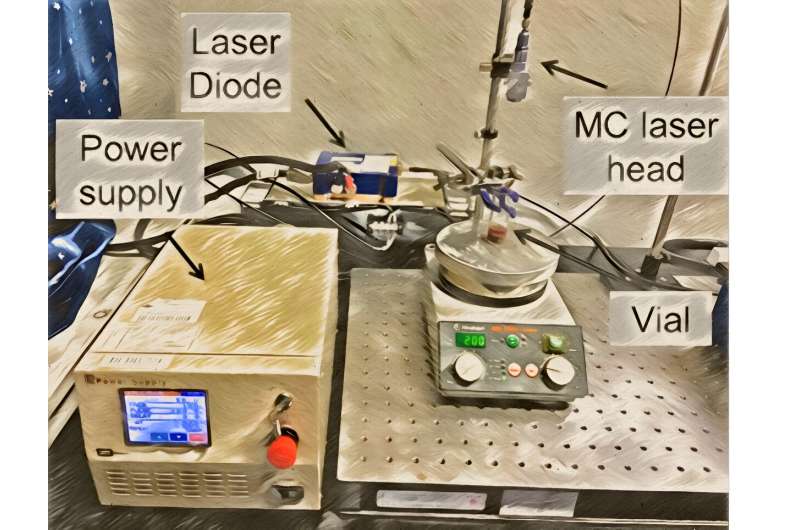
Pulsed laser ablation in liquid (PLAL) is a reliable and versatile technique for producing metal nanoparticles (NPs) in solution. Its advantages, including the absence of reducing agents, operational simplicity, high purity without purification steps, and ambient processing conditions, make it a preferred choice over conventional metal NP preparation approaches like the chemical reduction method.
The widespread adoption of PLAL across scientific and industrial research fields attests to its utility. However, the size and maintenance cost of traditional laser sources pose significant challenges for laboratories, particularly those not specialized in laser science.
Recognizing these hurdles, Professors Hidehiro Sakurai, Yumi Yakiyama and their team at Osaka University turned their attention to the microchip laser (MCL) system. Developed by the Taira group at the Institute of Molecular Science (IMS), MCL is a compact, low-power consumption giant-pulse laser system with a short cavity length of under 10 mm, making it well-suited for standard organic synthesis laboratories.
Despite the advantage of its size, the applicability of MCL’s specifications—especially its small pulse energy—to PLAL of an Au target was unknown. The research team aimed to understand how the differences in instrumental specifications contribute to the outcomes of PLAL of Au, with the goal of furthering benchtop synthesis and the direct application of NPs for catalytic purposes.
In their investigation published in the journal Industrial Chemistry & Materials, the team utilized MCL for PLAL of Au, focusing on the effects of small laser pulse energy (0.5 mJ), short pulse duration (0.9 ns), and low repetition rate (10 Hz) on ablation efficiency. The results revealed that MCL exhibited relatively high ablation efficiency despite having a much smaller pulse energy compared to conventional higher-power lasers (25 mJ/pulse, 12 ns duration, 10 Hz).
“Our study provides new insights into the preparation of Au NPs using the compact MCL system. Importantly, it opens avenues for the direct use of highly reactive NPs prepared by MCL in the development of new catalytic reactions within standard synthetic chemistry laboratories,” Sakurai said.
The research team includes Barana Sandakelum Hettiarachchi, Yusuke Takaoka, Yuta Uetake, Yumi Yakiyama, and Mihoko Maruyama, Yusuke Mori, Hiroshi Y. Yoshikawa, and Hidehiro Sakurai from Osaka University; and Hwan Hong Lim and Takunori Taira from the Institute of Molecular Science.
More information:
Barana Sandakelum Hettiarachchi et al, Uncovering gold nanoparticle synthesis using a microchip laser system through pulsed laser ablation in aqueous solution, Industrial Chemistry & Materials (2024). DOI: 10.1039/D3IM00090G
Provided by
Industrial Chemistry & Materials

READ MORE
Things I Look For When I Interview Candidates
Preparing for a job interview can be quite daunting and nerve-racking. It is something that [...]
New method for fabricating flexible electronics
Fig. 1: Schematic illustration of the steps involved in the direct roll printing process with [...]
Using liquid metals to synthesize high-entropy alloy nanoparticles
The TEM EDS mapping of the precursor with adjacent Ga NPs. The metal salts are [...]
Bill Weir’s Road to Optimism
Catch Bill’s 90-minute special on Saturday April 25, 2020 on CNN. Bill Weir is a [...]
How Automobile Ignition Systems Work
The internal combustion engine is an amazing machine that has evolved for more than 100 [...]
In Borneo’s Ruined Forests, Nomads Have Nowhere to Go
Tropical hardwoods wait to be milled into boards near the coastal city of Miri. Varial [...]
See Where Climate Science Conflict Has Invaded U.S. Classrooms
So far, nine states have tried to pass laws that encourage a “teach the controversy” [...]
9 Enormous Facts About Sperm Whales, Gigantic Creatures of the Sea
Sperm whales (Physeter macrocephalus) like his one have huge heads to hold their enormous brains. [...]